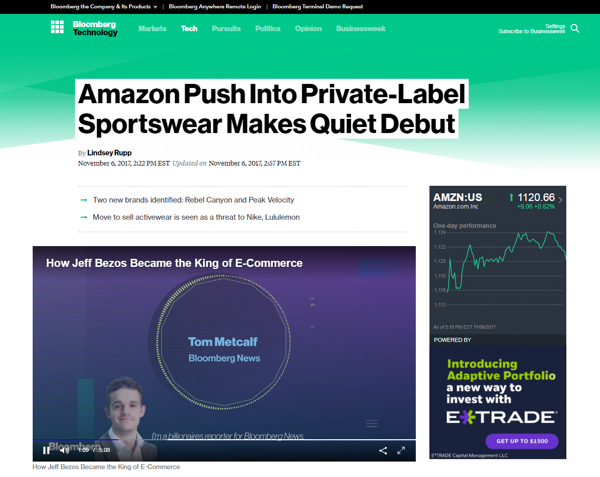To shore up its display business, Bloomberg Media is tapping its markets data to create custom display ads. Bloomberg now sells 27 different kinds, up from seven just two years ago, in formats that tap into Bloomberg data to give advertisers an ability to use real-time data about companies, commodities and stocks to deliver advertising that accurately reflects what’s going on in the financial world the moment a user sees it.
For example, if a company’s stock falls below a certain price, a visitor to Bloomberg’s owned and operated sites might see a special kind of ad creative.
A format called DataLock, for example, scans an article for company names, pulls out data that provides a live, day-over-day performance chart for those companies and pairs it with an advertiser’s message. Another, called Rithm, gathers highlights from the day’s markets activity and algorithmically creates an infographic that can be deployed as everything from a banner ad to a video advertisement on the Amazon Echo Show.
Some of the new ad units live in newer, more unfamiliar environs. Lens, a Chrome extension that allows users to access real-time data about companies and commodities mentioned in articles by mousing over them, secured Qualcomm as a launch sponsor. Others live inside of Bloomberg’s mobile app audience.

Bloomberg’s also expanded the team of people that designs ads from one to four, not only to speed up output but to better train Bloomberg’s sales staff on the merits of the new formats, which now account for a double-digit percentage of Bloomberg’s ad revenue, according to Derek Gatts, Bloomberg’s global head of ad trafficking, technology and innovation.
“If someone goes to one of our competitors, what they’re buying is adjacency, to content and audience,” said Michael Shane, the global head of digital innovation at Bloomberg. “But beyond a certain point, that’s not super connected to what’s happening in the world, minute by minute.”
The revenue from those products is up 81 percent year over year, Bloomberg claims, saying only that proceeds from the sale of those units amounted to over $10 million and contributed to the highest quarter of revenue in the history of Bloomberg Media.
“It’s not about how big the ads are,” Gatts said. “It’s about what you can stuff into them.”
In the United States, the display advertising market has been locked in a decline for many years, according to Interactive Advertising Bureau figures. Publishers, looking to prop up that corner of the business, have recently turned to custom banner formats, which lack the scale of most banner inventory but deliver superior performance, engagement and viewability.
That trade-off might hold questionable value to a mass consumer brand. But it is much more palatable for a brand targeting a group like financial professionals or day traders, who might amount to just a few million people. “This is an oasis in the desert for people we care very much about talking to,” said Tracy-Ann Goodwin, the evp of client strategy at the media agency Media Assembly.
Having to compete for the attention of such a small group of people makes it more important to have ads that stand out, Goodwin added.
Gatts and Shane both note that all of these new formats are reworked tirelessly in an effort to more efficiently meet client needs. But they also require substantial training and education effort for the sales staff. “If you’re creating new ad products and you don’t have to retrain the entire sales force [to sell them], you’re not being ambitious enough,” Shane said.
More in Media

A timeline of the major deals between publishers and AI tech companies in 2025
Here’s a list of all the major deals signed between publishers and AI tech companies in 2025.

No playbook, just pressure: Publishers eye the rise of agentic browsers
For the bulk of publishers, Google is, as ever, the one to watch. It’s already got agentic features within its Chrome browser, but that’s the tip of the iceberg, some say.

The biggest SEO lessons in 2025 for publishers
KPIs are changing, more AI search data is becoming available, and publishers are looking beyond search to grow their audiences and revenue.








